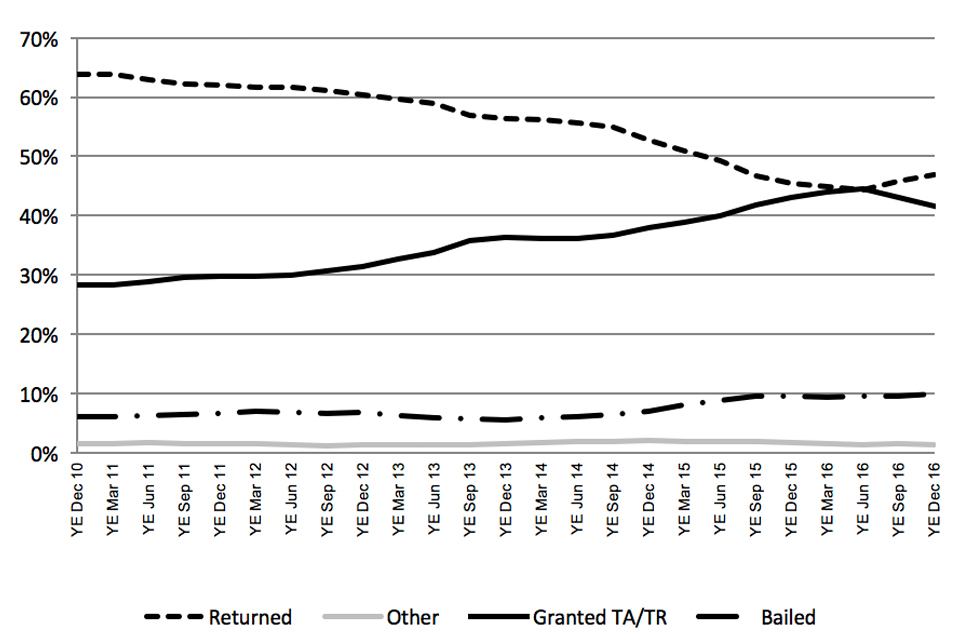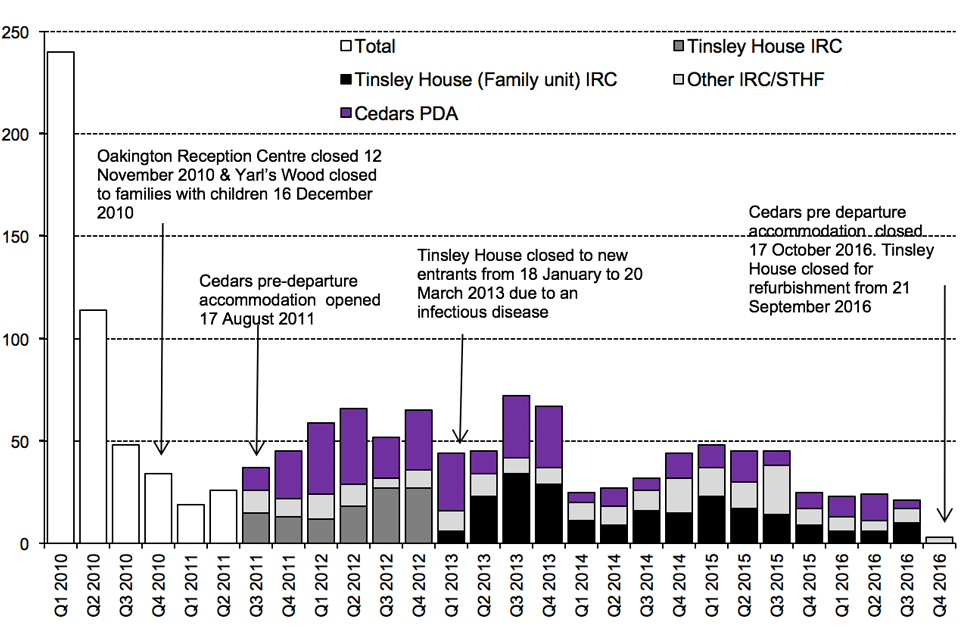Detention
Published 23 February 2017
Valid: 23 February 2017 to 24 May 2017
Data relate to 2016 and all comparisons are with 2015, unless indicated otherwise.
Back to Immigration statistics October to December 2016 content page.
This is not the latest release. View latest release.
1. Key facts
The number of people entering detention in 2016 decreased by 11% to 28,908 from 32,447 in the previous year.
Over the same period there was a 14% decrease in those people leaving detention (from 33,226 to 28,661). The proportion of detainees being returned or voluntarily departing the UK on leaving detention increased slightly from 45% in 2015 to 47% in 2016. Conversely, the proportion of detainees granted temporary admission or release (TA/TR) decreased slightly from 43% to 42%.
As at the end of December 2016, 2,738 people were in detention, 5% more than the number recorded at the end of December 2015 (2,607).
2. People entering, leaving and in detention, solely under Immigration Act powers
| Year | Entering detention | Leaving detention | In detention (1) |
|---|---|---|---|
| 2012 | 28,905 | 28,575 | 2,685 |
| 2013 | 30,418 | 30,030 | 2,796 |
| 2014 | 30,364 | 29,674 | 3,462 |
| 2015 | 32,447 | 33,226 | 2,607 |
| 2016 | 28,908 | 28,661 | 2,738 |
| Change: latest year | -3,539 | -4,565 | +131 |
| Percentage change | -11% | -14% | +5% |
2.1 Table notes
Source: Home Office, Immigration Statistics October to December 2016, Detention tables dt 01 q, dt 05 q and dt 11 q.
(1) The ‘in detention’ figures are as at the end of December in each year.
3. People leaving detention by nationality
In 2016, 28,661 people left detention. Indian nationals accounted for the highest number of people leaving (2,754), a decrease of 17% compared with 2015 (3,330).
3.1 Top 5 nationalities of people leaving detention, 2016
| Nationality | Leaving detention | % Returned on leaving detention (1) | % Granted TA/TR on leaving detention |
|---|---|---|---|
| India | 2,754 | 31% | 54% |
| Pakistan | 2,545 | 34% | 51% |
| Albania | 2,137 | 80% | 12% |
| Iran | 1,558 | 6% | 92% |
| Bangladesh | 1,527 | 27% | 59% |
Table notes
Source: Home Office, Immigration Statistics October to December 2016, Detention table dt 08 q.
(1) Returned on leaving detention includes enforced returns, voluntary returns and refused entry at port and subsequently departed.
3.2 EU nationals leaving detention
In 2016, 4,519 EU nationals left detention, 24% more than in 2015 (3,647). The largest number was Romanian nationals (1,521 or 5% of the total of all nationalities leaving detention). The second and third largest groups were Polish nationals (1,130 or 4%) and Lithuanian nationals (577 or 2%) respectively.
The proportion of EU nationals being returned or voluntarily departing the UK on leaving detention in 2016 was 89% (the same as 2015), compared with 39% for non-EU nationals.
4. Reasons for people leaving detention
After a steady decline from 64% in the year ending March 2011 to 44% in year ending June 2016, in the proportion of detainees being returned or voluntarily departing the UK on leaving detention the figure has climbed back to 47% in the year ending December 2016. Conversely, over the same period, the proportion of detainees granted TA/TR have increased from 28% to 45% and then declined to 42%. The proportion of detainees granted bail has increased from 6% to 10%.
4.1 Reasons for people leaving detention (%)

The chart shows the reasons for leaving detention as a percentage of the total from year ending December 2010 to the latest rolling year. The data are available in Table dt 05 q.
Chart notes
Source: Home Office, Immigration Statistics October to December 2016, Detention table dt 05 q.
Granted leave to enter / leave to remain (LTE/LTR); granted temporary admission / temporary release (TA/TR).
Returned on leaving detention includes enforced returns, voluntary returns and refused entry at port and subsequently departed.
More detailed information on reasons for leaving detention may be found in the user guide.
5. Length of detention
During 2016, 28,661 people left detention. Of these, 64% had been in detention for less than 29 days, 18% for between 29 days and 2 months, and 11% for between 2 and 4 months. Of the 1,848 (6%) remaining, 179 had been in detention for between 1 and 2 years, and 29 for 2 years or longer.
In the same period, over a third (35%) of people leaving detention had been detained for 7 days or less (10,143). Of these, 54% (5,482) were returned; 43% (4,398) were granted TA/TR; and the remaining 3% were bailed (50), granted LTE or LTR (38), or released for other reasons (175). Of the 208 detained for 12 months or more, 38% were bailed, 29% were returned, and 29% were granted TA/TR.
As at 31 December 2016, the longest length of time a person had been currently detained for was 1,333 days.
6. Children in detention
There were 71 children entering detention in 2016, 56% lower than the previous year (163). This was a 94% fall compared with the beginning of the data series in 2009 (1,119). Only 3 children entered detention in the last quarter of 2016 reflecting the closure of Cedars Pre-departure Accommodation (PDA) on 17 October 2016 and the temporary closure of Tinsley House Immigration Removal Centre (IRC) for refurbishment.
Of the 74 children leaving detention in 2016, 52 were granted TA/TR and 17 were returned from the UK. Of those leaving detention, 67 had been detained for 7 days or less, 3 for between 8 and 14 days, 1 for between 15 and 28 days and 3 for 29 days or longer. There were no children in detention as at 31 December 2016.
6.1 Children entering detention, solely under Immigration Act powers

The chart shows the number of children entering detention between the first quarter of 2010 and the latest quarter. The data are available in Table dt 02 q.
Chart notes
Source: Home Office, Immigration Statistics October to December 2016, Detention table dt 02 q.
Oakington Reception Centre closed on 12 November 2010; Yarl’s Wood closed to families with children on 16 December 2010. Cedars PDA opened on 17 August 2011.
From the third quarter of 2011, all child detainees in Tinsley House are shown in Tinsley House IRC. From January 2013 child detainees in Tinsley House IRC, as part of a family, are shown in Tinsley House (Family Unit) IRC; the remainder are shown in Other IRC/STHF (short-term holding facilities).
Tinsley House IRC closed to new entrants from 18 January to 20 March 2013 due to an infectious illness.
Tinsley House IRC closed for refurbishment from 21 September 2016.
Cedars PDA closed on 17 October 2016.
7. Immigration detainees in prisons
As at 09 January 2017, there were 484 detainees held in prison establishments in England and Wales solely under immigration powers as set out in the Immigration Act 1971 or UK Borders Act 2007.
8. Data tables
Further data on detention are available in Detention tables dt 01 to dt 14 q.
9. Background information
The figures in this topic brief relate to the number of people entering, leaving or in detention, solely under Immigration Act powers, at IRCs, STHFs and PDA). An individual may be held and remain in immigration detention for a variety of reasons, including reasons within and outside the control of the Home Office. Those outside the control of the Home Office may include but are not exclusively: individual compliance with immigration procedures, including providing appropriate paperwork; and barriers to removal relating to the individual’s personal circumstances or circumstances related to the intended country of return. Reasons within the control of the Home Office include: where the Home Office has assessed it is not in the public interest to release the individual pending return.
9.1 Migration transparency data webpage
A range of key input and impact indicators are currently published by the Home Office on the Migration transparency data webpage.
